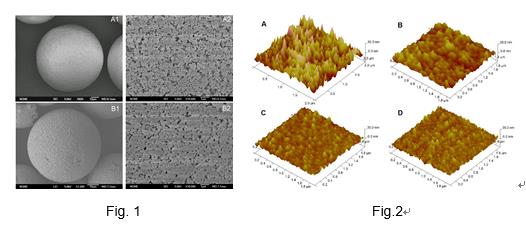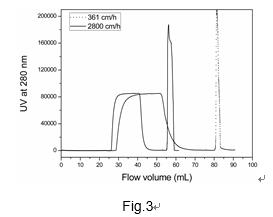High capacity at high flow rate has been in pursuit of the goal for high throughput chromatographic separation of proteins. Especially, the recent rapid development of bio-pharmaceutial industry is a great challenge for separation technology. Generally, the chromatographic media used for separation of proteins is microspheres based on polysaccharide, such as agarose (SepharoseGE) and dextran (Sephadex). The media with small pores (5-30 nm) was not favor to the mass transfer of proteins, especially macromolecular size proteins. In order to solve the problem, the group led by Prof.MA Guanghui in the Institute of Process Engineering(IPE), Chinese Academy of Sciences, explored a kind of gigaporous polymer microspheres, including poly(styrene-divinyl benzene) (PS-DVB) and polyglycidyl methacrylate-divinyl benzene (PGMA-DVB), with 300-500 nm pore size, which can be used as a perfusion chromatographic support. The media enables better access of macromolecules to the inner of the particle through the combination of convective and diffusive flow. As a consequence, the time required for a chromatographic separation is reduced meanwhile the loading capacity is independent of the superficial velocity. Based on the good mass transfer property, we modified PGMA-DVB microspheres using polyethyleneimine (PEI) with abundant amino groups that was hydrophilic molecular. The modified microspheres showed good permeability and revealed a certain mechanical strength. After modification, the protein recovery increased from 40% to >90%. The protein recovery increased with the branched generations and the first and second generations could give the protein recovery of 93% and 96%, respectively. Meanwhile, it was found that the PEI chains in the modified microspheres changed their construction from the extended to the collapsed state with increase of NaCl concentration. And the corresponding pore size of the modified microspheres increased with salt concentration through low-field nuclear magnetic resonance. Dynamic binding capacity of proteins on the modified supports did not significantly change with increase of the flow rate. The media showed good performance for separation three model proteins at high flow rate of 1084 cm/h. This modified gigaporous microspheres had a large potential in application for rapid separation of biomolecules. The results have been published inJournal of chromatography A 2014,1343,109-118. 

Fig.1 SEM of PGMA-DVB and PGMA-DVB-PEI (A1 and A2, PGMA-DVB; B1 and B2, PGMA-DVB-PEI) Fig.2 AFM of PGMA-DVB-PEI in various NaCl solution (A, 0 M; B, 0.3 M; C, 0.5 M; D, 1.0 M) Fig.3 DBC of PGMA-DVB-PEI in various flow rates.(Image by IPE)
|